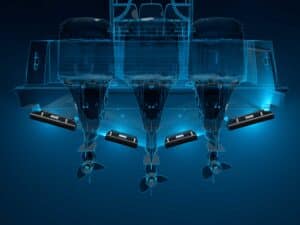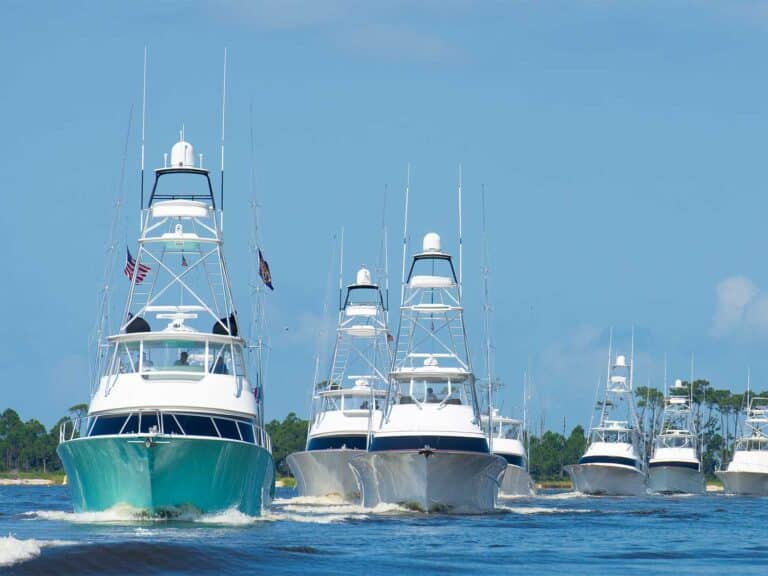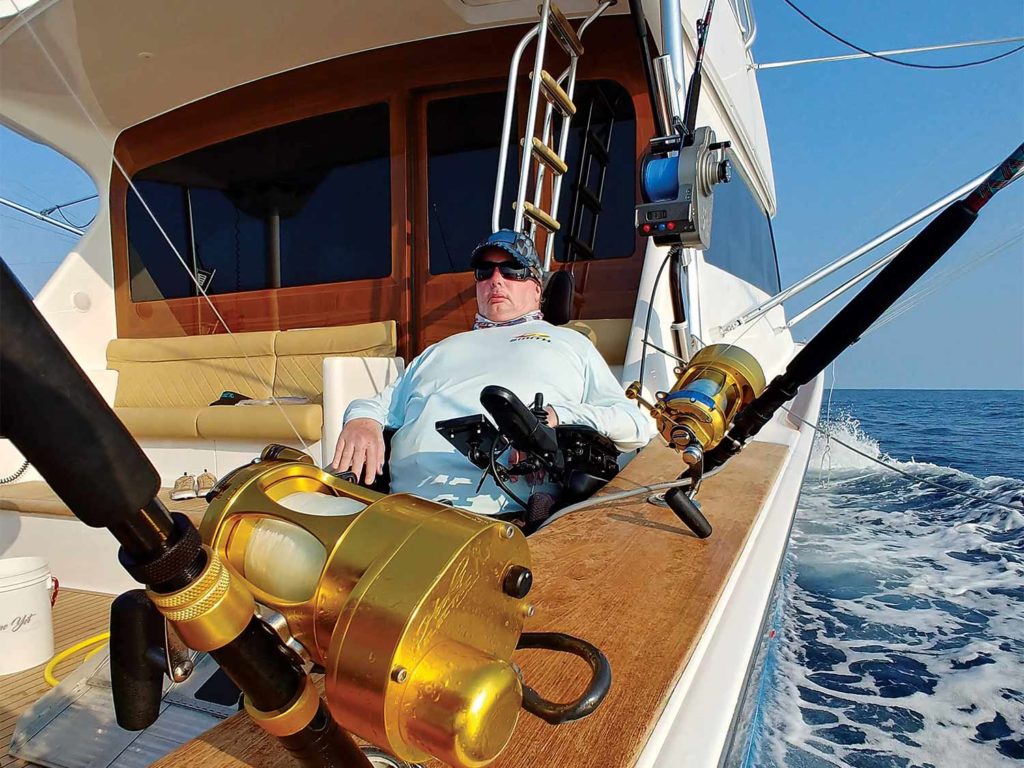
“The only thing we can do is play on the one string we have, and that is our attitude. I am convinced that life is 10 percent what happens to me, and 90 percent how I react to it. And so it is with you. We are in charge of our attitudes.” ¶ When Charles Swindoll penned those words in 1990, he had all people in mind. However, that quote is a mission statement for Perry Nichols, who lives life to the fullest, accepts his circumstances—and if there is a will, he and his friends will make a way.
At the age of 13, Nichols was playing football in North Carolina for a team that won a state championship. He noticed he was running and reacting slower with each game, and his concerned parents took him to the local doctor. Nothing was out of the ordinary, so they were advised to visit Duke Medical Center. There, Nichols was diagnosed with muscular dystrophy, which causes progressive weakness and loss of muscle mass.
Nichols’ prognosis was uncertain, because research on MD more than 40 years ago was not as advanced as it is now. “I didn’t think I would live to be 25 or 30 and here I am at 61, fishing offshore for billfish,” he says.
He has always had a passion for fishing, beginning with freshwater when he owned a Ranger bass boat. As his condition worsened, his arms and shoulders became weaker and he was unable to cast a rod and reel. As the disease progressed, he used cane poles for crappie until he could no longer hold a simple piece of cane in his hands. Nichols sold the Ranger and gave his fishing gear to the children in his local community.
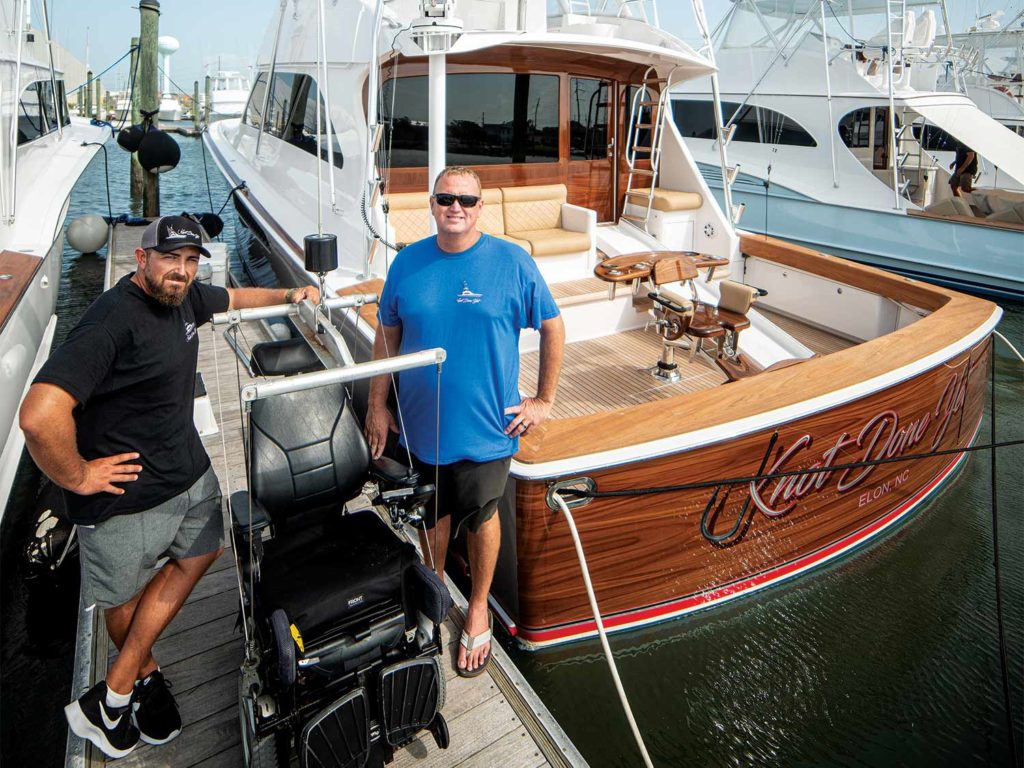
A Chance Meeting
Though Nichols had been affected by a devastating situation, he stayed positive. After I met him at the 2019 Big Rock Blue Marlin Tournament, this personal attribute is clear. His quiet personality and calm presence draws people to him. Throughout his life, he’s been fortunate to meet many people—one of those is Darrell Gwynn. He was a world-champion drag racer until an accident left him paralyzed in 1990. Gwynn has established several charitable organizations to cure paralysis and provide automated wheelchairs to those in need; he’s also the owner of the Darrell Gwynn Ventures drag-racing team. He partners with Hooker reels and Bass Pro Shops to let people with disabilities know how they can still enjoy the outdoors and fishing in particular.
Soon after he met Gwynn’s parents, Nichols was invited by Darrell himself to go fishing in Islamorada, using electric reels in a saltwater environment. That led to Nichols chartering a few times in South Florida where he and Gwynn caught sailfish. According to Keith Jones, Nichols’ lifelong friend and caretaker when they travel, “They share a bond that a nondisabled person cannot comprehend. It is a special and very unique friendship.”
Nichols soon realized that with the assistance of electric reels with wired remotes and his own boat, he could target offshore species, including billfish. So he told his wife, Lisa, he wanted to buy a boat. From the beginning, she supported him in his decision to fish offshore.
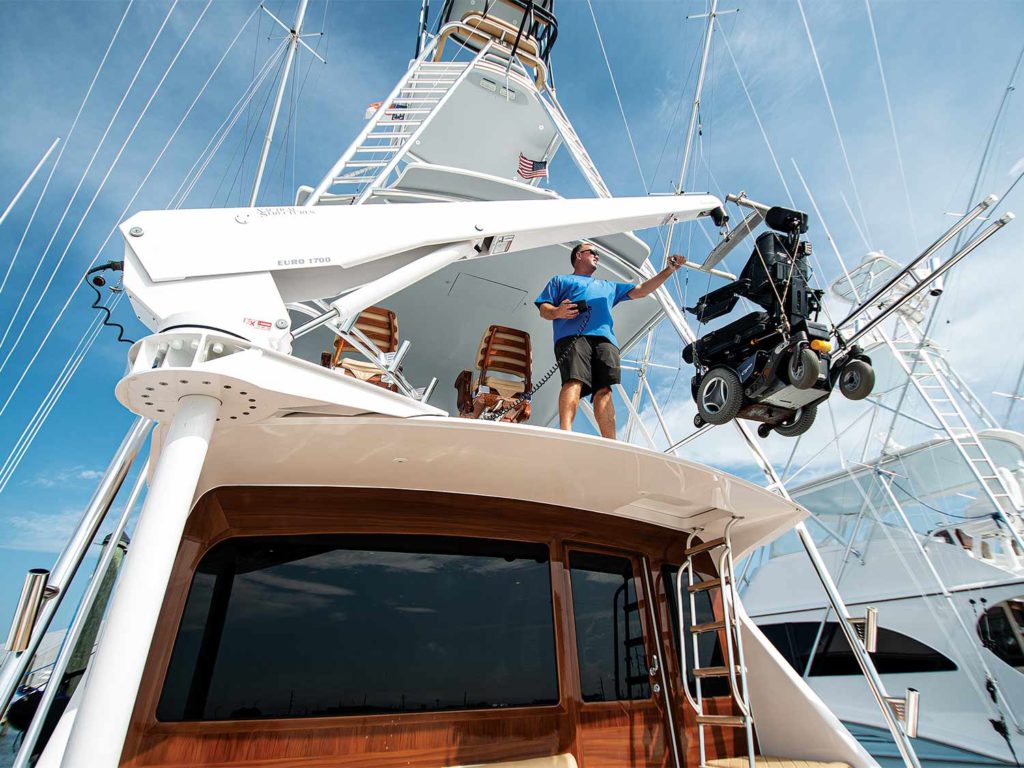
Nichols told his friend and charter boat owner, Todd Porterfield, of his decision to purchase a boat. Porterfield called Earle and Chris Hall of Bluewater Yacht Sales, who showed up at Nichols’ office in central North Carolina two days later. In late 2017, Hall began to search for the perfect boat that would fit Nichols’ needs, and another friendship began.
The Search is On
Hall knew exactly what he was looking for and he knew the timeline Nichols had in place: to fish the Big Rock Blue Marlin Tournament in June 2018. While Hall found two boats quickly, both of those contracts fell through.
Falling behind and approaching the deadline while attending the Miami International Boat Show in 2018, Hall found a 2008 64-foot Viking. He was familiar with the boat, the owner and the heritage—and he knew this was the one. An offer was presented, and the boat arrived at the Bluewater yard in early March.
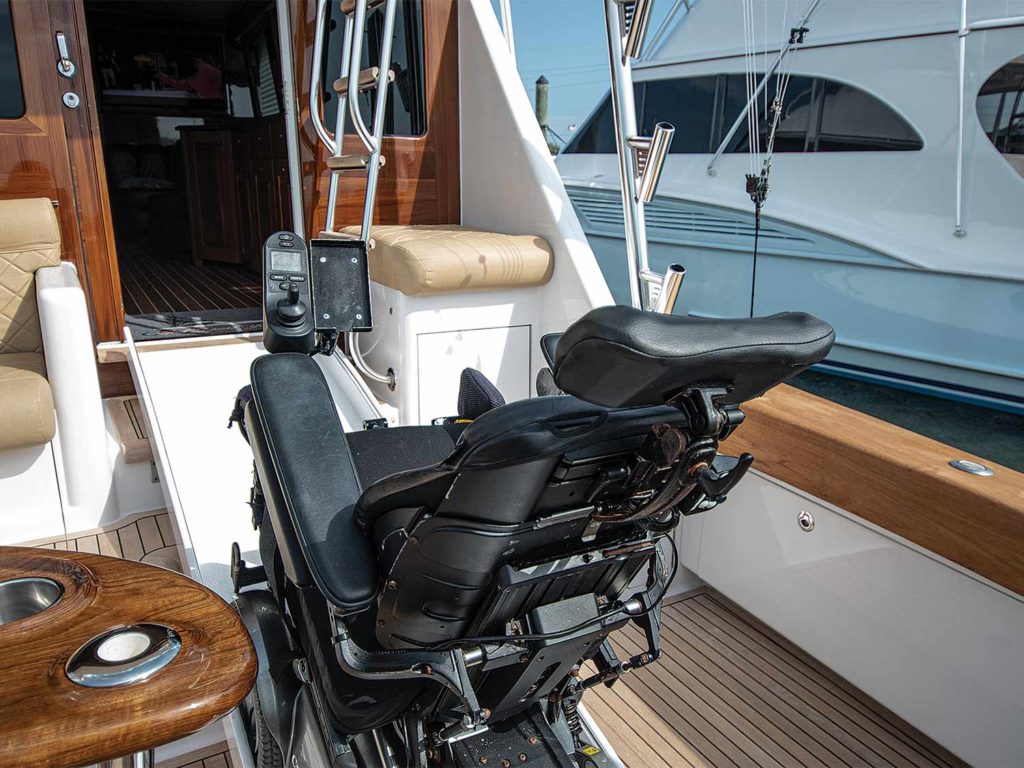
The Transformation
Hall and his team at Bluewater are no strangers to reconfiguring boats for people with disabilities. They understand the importance of listening to their customers’ exact needs, rather than telling them what they need for their conditions and access requirements. Not only did the boat require an extensive reconfiguration, the Bluewater team had just three months to complete the task, as the date for the Big Rock loomed.
Hall assembled a team led by engineer Brian Motter. The goals were to determine the best way to get Nichols on and off the boat; how to get him into the salon; how to access the master stateroom and head; and to install a Seakeeper for added stability. The transformation from a stock Viking to Knot Done Yet was underway.
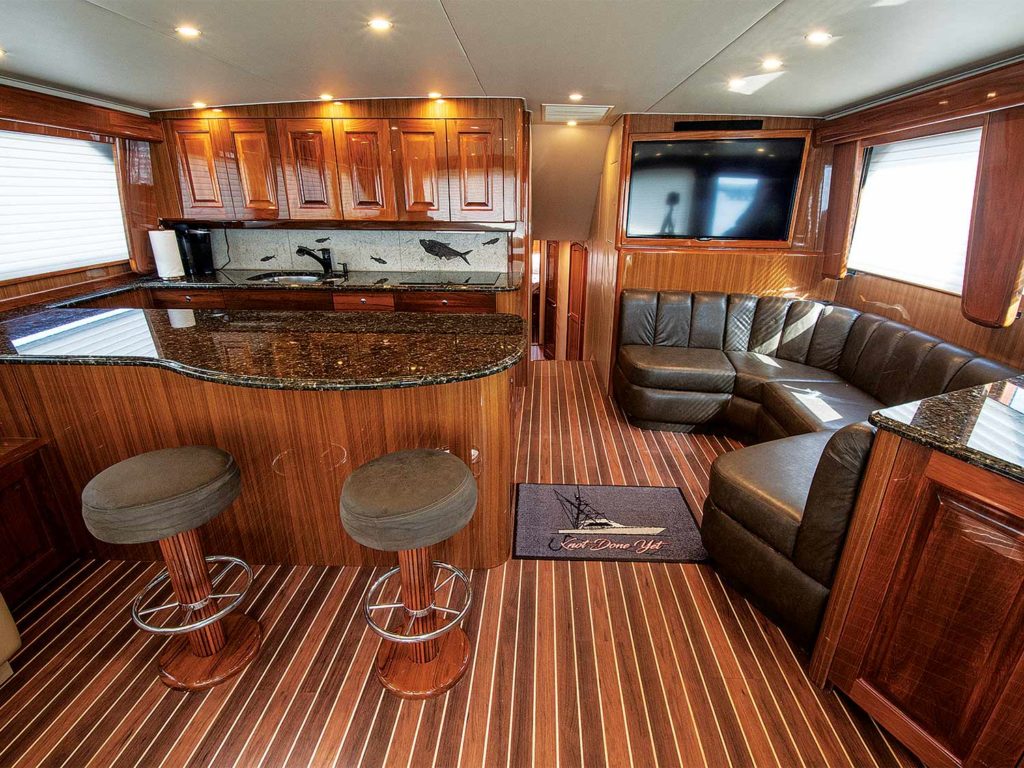
What appeared to be the first task—getting Nichols aboard—quickly grew difficult. Almost none of the davit manufacturers wanted the liability involved in lifting a person on board a boat in an automated wheelchair. Hall had partnered with Nautical Structures in the past, and the company agreed to provide the davit and assist in any way possible. While most davits are bow-mounted, this one needed to be near the cockpit. So the team designed and manufactured a massive post and platform, substantially tying the davit into the bridge overhang and cockpit deck. They didn’t stop there, because Nichols also wanted to have access to the bridge. There were two apparent complications: the hardtop height and how to get the wheelchair through the belly band at the rear of the bridge. They created access by cutting the belly band in half while the outer sections attached to the tower legs were reconfigured to swivel out, creating a gate.
Now one would think that fishing offshore in rough conditions would make the belly-band gate rattle, but after fishing with them during the 2019 Big Rock tournament in some nasty conditions, I did not hear one squeak or rattle, attesting to the exact tolerances of the design and craftsmanship. The other component of bridge access was the height of the hardtop and allowing the davit to swivel beneath it with an automated wheelchair. To solve that matter, a harness was created, allowing less than a half-inch of clearance under the hardtop. Nichols now had his bridge access.
A Step Up
Next on the list was access from the cockpit to the salon. The first attempt was an aluminum ramp that mounted to brackets under the salon door. After fishing the 2018 Big Rock, the team realized they needed a better solution. The aluminum ramp could not be easily stored because of its metal construction; access to the starboard side of the cockpit was impaired, and even with a nonskid surface, the aluminum was slippery when wet. Later in the tournament season, a lighter carbon-fiber ramp was developed that solved a few issues. The new ramp is lighter and can be stored in the salon when fishing. Also, an aggressive nonskid pattern allows everyone to navigate the ramp when it’s in the cockpit.
Within the salon, two changes were made. The first was removing the starboard-side dinette table, which created a wider lane to reach the companionway steps. Release Marine fabricated a custom fold-out table that is not attached to the salon sole, so it can be moved to the dinette or placed inside the L-shaped sofa on the port side. The second step was removing the carpet, replacing it with a wood laminate for durability, ease of cleaning and easier movement for Nichols’ chair.
From the beginning, Nichols wanted to stay on the boat during tournaments and any extended fishing trips, including a 30-day stay in Chub Cay where the team fished 22 days. How would he access the master stateroom and head with a four-step staircase between the salon and the companionway while staying in his automated chair?
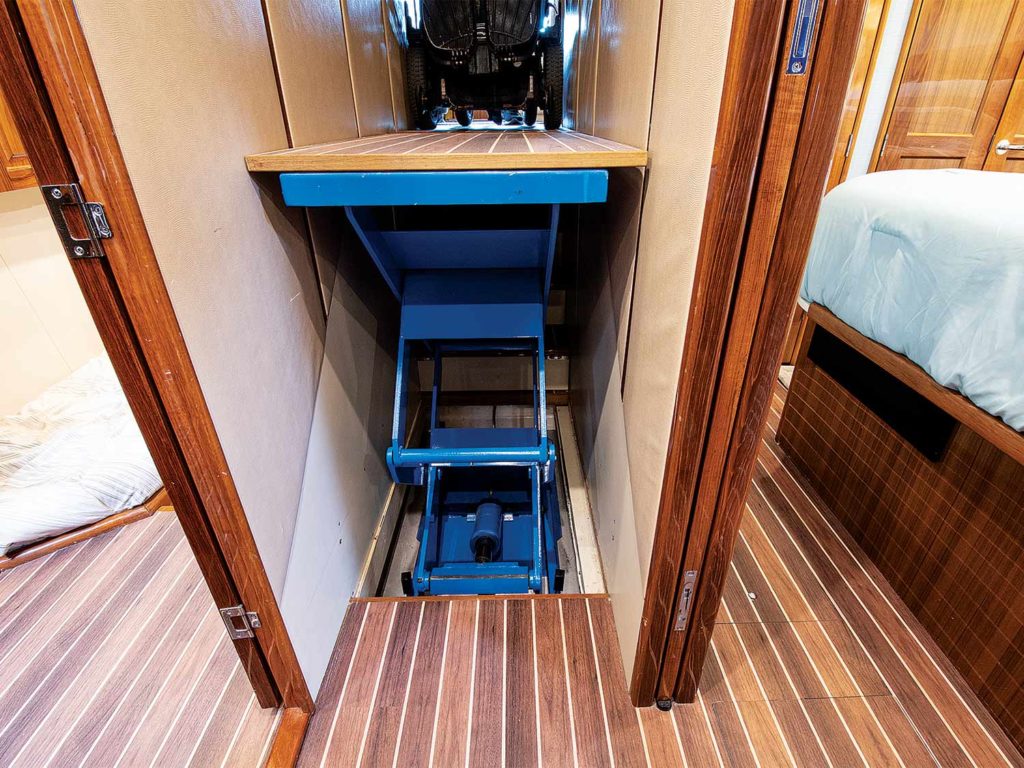
The solution involved cutting out the staircase and attaching the entire component to a slide system with safety locks. This allows the stairs to slide aft below the salon floor, exposing a scissor-lift elevator that has the same teak-and-holly flooring to match the companionway’s. While this might seem to be a straightforward process, it was quite complex because of the number of safety measures that had to be in place. The lift cannot be activated while the stairs are in their normal position, and the lift was programmed with precise starts and stops to allow seamless transitions to the salon and companionway floors.
Now that companionway access had been achieved, Nichols needed improved access to the master stateroom. The Bluewater team removed the entry door and widened the opening to 4 feet. They engineered a 4-foot trifold pocket door made of high-gloss teak to match the remaining doors. When the door is open, the master stateroom looks massive. The open concept is enhanced by the removal of a hutch on the forward wall, which provided enough room for a double-door access to the master head.
The head itself was raised approximately 8 inches to allow easier transfer from the chair. All the modifications appear to be from the Viking factory—one would never know the difference.
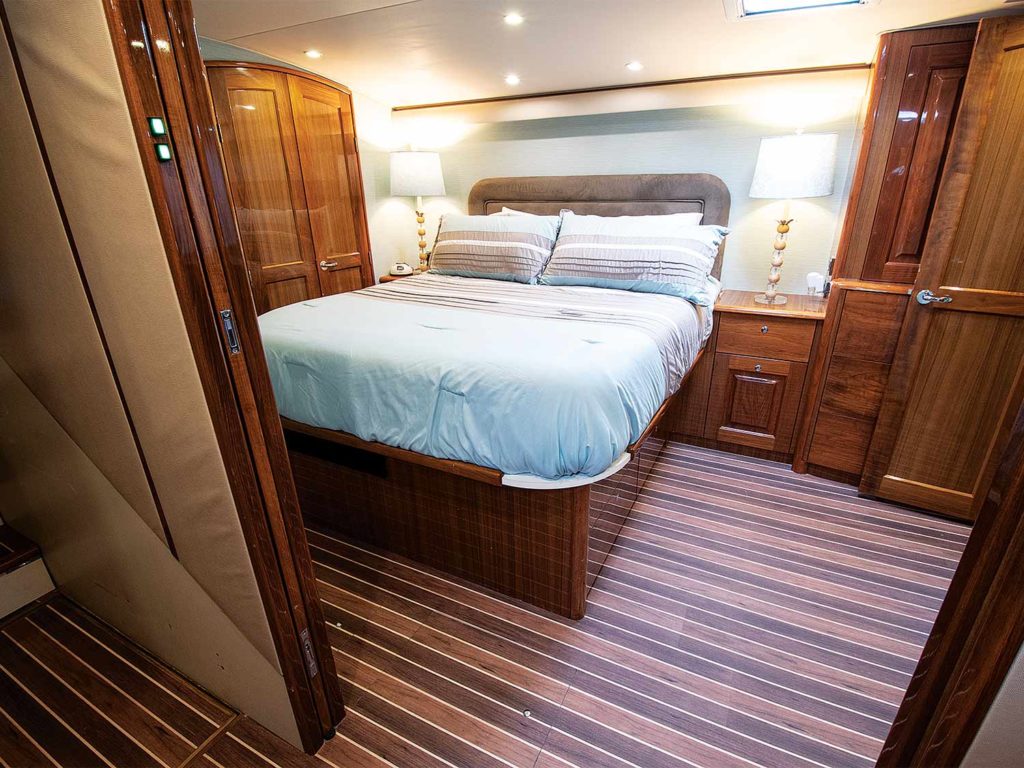
Nichol’s chair also needed modification. The Bluewater team reconfigured it to make its profile slightly narrower to allow for a smaller-profile cockpit/salon ramp and to avoid widening the salon door. In addition, the team found smaller wheels with more swivel ability. Foldable, narrow armrests also allowed easier access to the salon. As with the bridge access, the tolerances are tight, yet the process works flawlessly.
With the 2018 Big Rock tournament approaching, all the tasks were complete except the installation of the Seakeeper. The 2008-model boats were not built to accommodate Seakeepers and this job was a major project. So, the team decided to fish the Big Rock and Hatteras Marlin Club tournaments without a gyrostabilizer.
Read Next: Fishing with combat veterans in Costa Rica
Hall relates a tale about those 2018 tourneys and how Nichols inadvertently set a standard as he fished without a Seakeeper: Several of the owners and captains grumbled to Jarrett Bay Boatworks President Randy Ramsey about how rough the fishing conditions had been. Ramsey retorted, “Perry Nichols and the Knot Done Yet were out there for four days in a row with no complaints!” He labeled Nichols a game-changer, referring to how he lives his life to the fullest.
After the Hatteras Marlin Club event, Bluewater had one month to complete the Seakeeper 26 installation. It was indeed a major project and included a partial cockpit deck removal and reconfiguration of the fuel tanks, along with stringer modifications to handle the stress on the hull. While the job was laborious, Bluewater finished right on time.
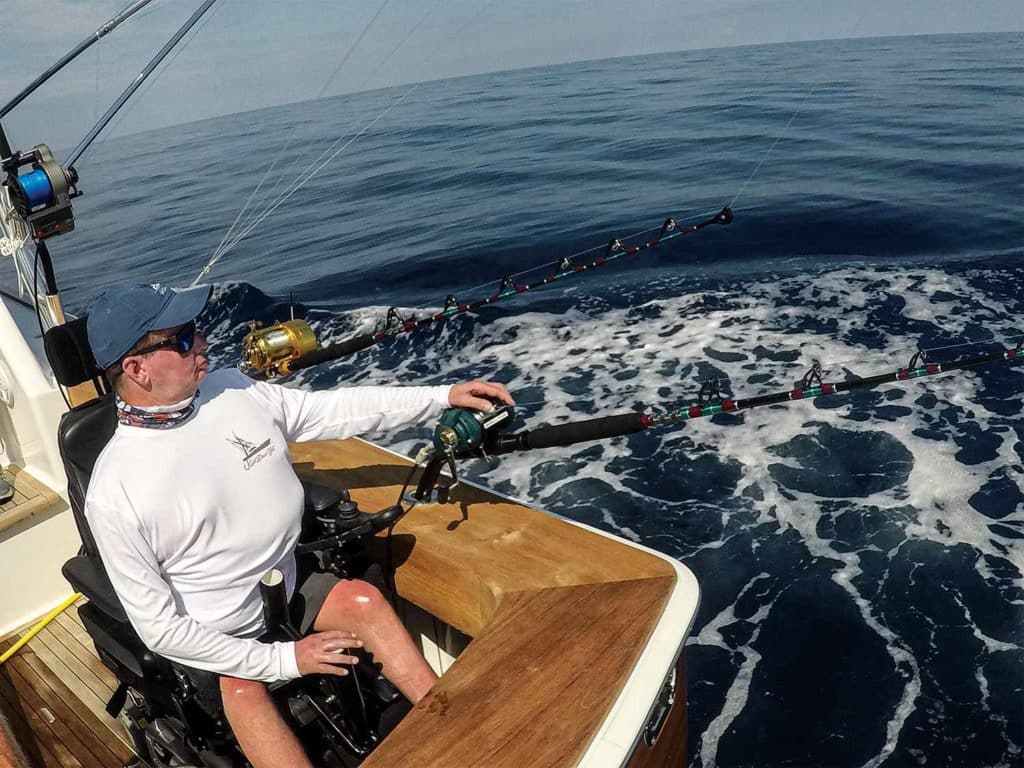
Tournament Fishing Rules
The Knot Done Yet required three months at Bluewater Yacht Sales to prepare her for fishing tournaments in 2018. Simultaneously, other preparations and considerations had to be addressed with the various tournament committees. Most rules did not allow any type of electric reel for angling, only for teasers and dredges.
The Big Rock Blue Marlin Tournament, Hatteras Marlin Club and the Virginia Beach Billfish Tournament boards all amended their rules to allow electric reels in 2018. This action welcomed people with disabilities, letting them fish billfish tournaments while also showing the tournaments’ support for the disabled.
When many of these rules were established originally, rules committees believed that an electric reel was an advantage. They now understand that an electric reel, especially for someone with a disability, can be a huge disadvantage. The rod stays in the rod holder no matter where the fish moves. In many cases, because no one else can touch the reel, the angler might or might not be able to adjust the drag throughout the battle.
For 2019, the Pirates Cove Billfish Tournament amended its rules to authorize the use of electric reels for angling. These decisions will hopefully spur other tournament committees to permit electric reels, allowing anglers with disabilities to fish any tournament within the United States and beyond.
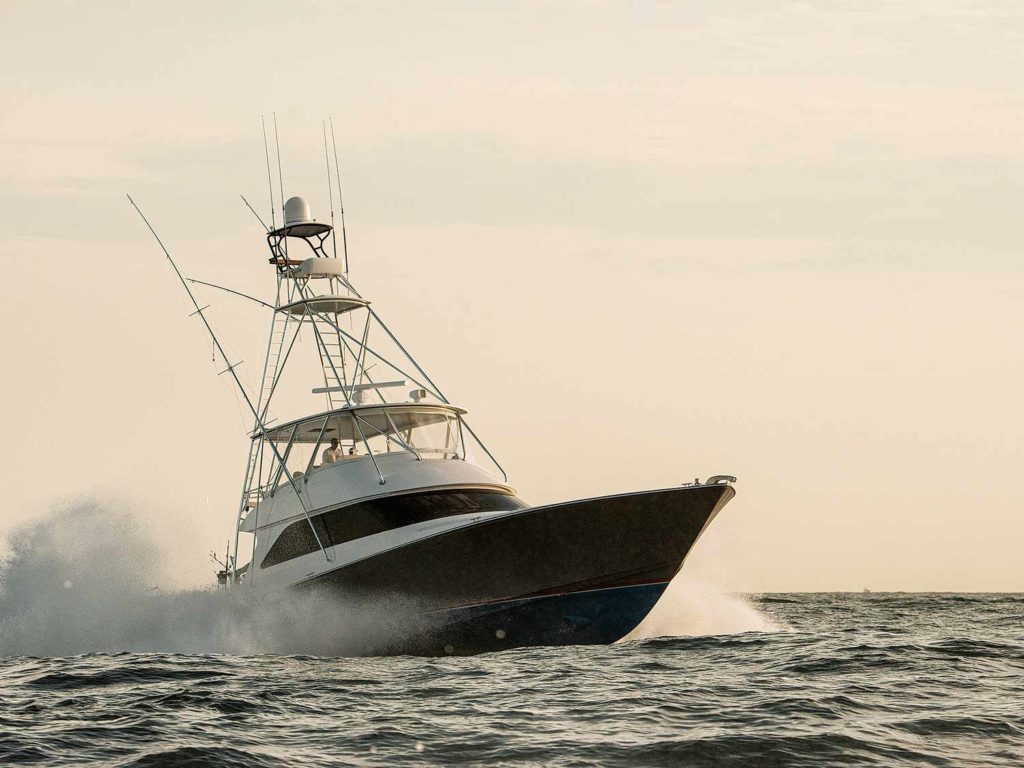
No “I” in Team
Fortunately, I was able to spend some time with the members of the Knot Done Yet team and fish with them during the 2019 Big Rock tournament.
“You will never hear the word ‘I’ come out of Perry Nichols’ mouth,” Jones says. “He has been blessed in his life and has been blessed with an amazing group of friends—not crew—but true friends that travel and fish with him.” Everyone on the team is on the same page, doing everything they can to make memories with Nichols.
Those who tournament fish understand that although there are many boats and even more people, the community is quite small and extremely helpful. While on board Knot Done Yet, I witnessed the most perfect example of brotherly love that I’ve ever seen. Jones does not leave Nichols’ side while on the boat and provides for his every need. Make no mistake, while he is fishing, Nichols is no different than any other angler, 100 percent focused on watching the water and the baits. As he says, “Don’t talk to me while we’re fishing.” Not that he won’t speak, it’s just an example of that laser focus.
In addition to Jones, Nichols’ mate and captain couldn’t be a better match for the Knot Done Yet. Capt. Mark Rogers is experienced, with an excellent reputation for putting anglers on the fish as well as patience, maintenance and going above and beyond to do whatever needs to be done to ensure a great day on the water. Mike Adkins is a tenured mate with the same attitude and personality as Rogers. His attention to detail regarding baits, tackle maintenance and anything Nichols might need for fishing is second to none.
If you happen to be fishing a tournament and see Knot Done Yet on the docks, I would strongly encourage you to stop by and talk with Perry Nichols or any of his friends. You will walk away a better person.



